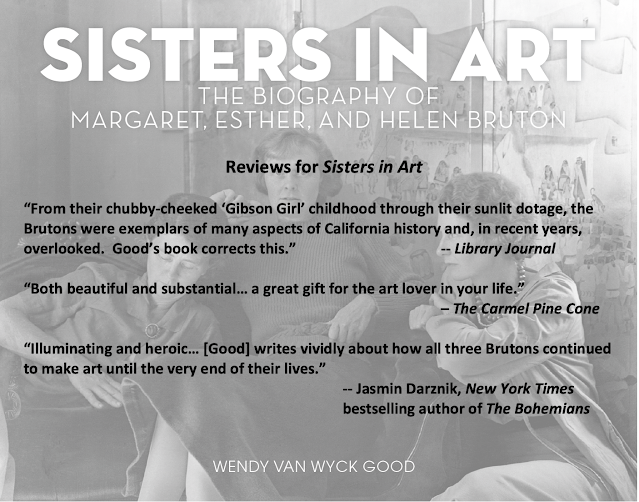SISTERS IN ART is now available wherever books are sold!
Educated at art schools in New York and Paris, the Brutons ran in elite artistic circles and often found themselves in the company of luminaries including Frida Kahlo, Diego Rivera, Henri Matisse, Armin Hansen, Maynard Dixon, Imogen Cunningham, and Ansel Adams. Their contemporaries described the sisters as geniuses, for they were bold experimenters who excelled in a wide variety of mediums and styles, each eventually finding a specialization that expressed her best: Margaret turned to oil paintings, watercolors, and terrazzo tabletops; Esther became known for her murals, etchings, fashion illustrations, and decorative screens; and Helen lost herself in large-scale mosaics.
Although celebrated for their achievements during the 1920s and 1930s, the Brutons cared little about fame, failing to promote themselves or their work. Over time, the "famous Bruton sisters" and their impressive art careers were nearly forgotten. Now for the first time, Sisters in Art reveals the contributions of Margaret, Esther, and Helen Bruton as their works continue to inspire and find new appreciation today.
Full review from Library Journal:
Good, Wendy Van Wyck. Sisters in Art: The Biography of Margaret, Esther, and Helen Bruton. West Margin. Oct. 2021. 232p. ISBN 9781513289519. $29.99. FINE ARTS
This sweeping biography profiles three forgotten artistic virtuosi—the daughters of a wealthy San Francisco tobacco executive—who achieved distinction with paintings, terrazzo mosaics, and murals designed for steamship salons, prestigious hotels, and public buildings. Margaret, Esther, and Helen Bruton (alumnae of New York’s Art Students League and Parsons School of Design) combined collaborative fame with individual achievement, culminating in a preposterously massive 8,000-square-foot mural (now lost) that dominated the 1939 Golden Gate International Exposition. The Brutons were leading figures in artists’ colonies in Carmel, Taos, and Ojai and hobnobbed with the likes of Georgia O’Keeffe, Ansel Adams, and Imogen Cunningham. Archivist Good (editor of a blog about the Bruton sisters) makes the case that the Brutons are as interesting for their involvement in historic American artist communities as they are for their art, much of which epitomizes mid-century modern style. (Helen even designed tiles for Gladding-McBean.) Great stories abound in this book, including the goings-on of the “Monterey Group” of painters and an encounter with a teetotaling Henri Matisse at a North Beach cocktail party. If California had a Belle Époque, this was it. VERDICT From their chubby-cheeked “Gibson Girl” childhood through their sunlit dotage, the Brutons were exemplars of many aspects of California history and, in recent years, overlooked. Good’s book corrects this.
—Douglas F. Smith, Oakland P.L., CA



Comments
Post a Comment